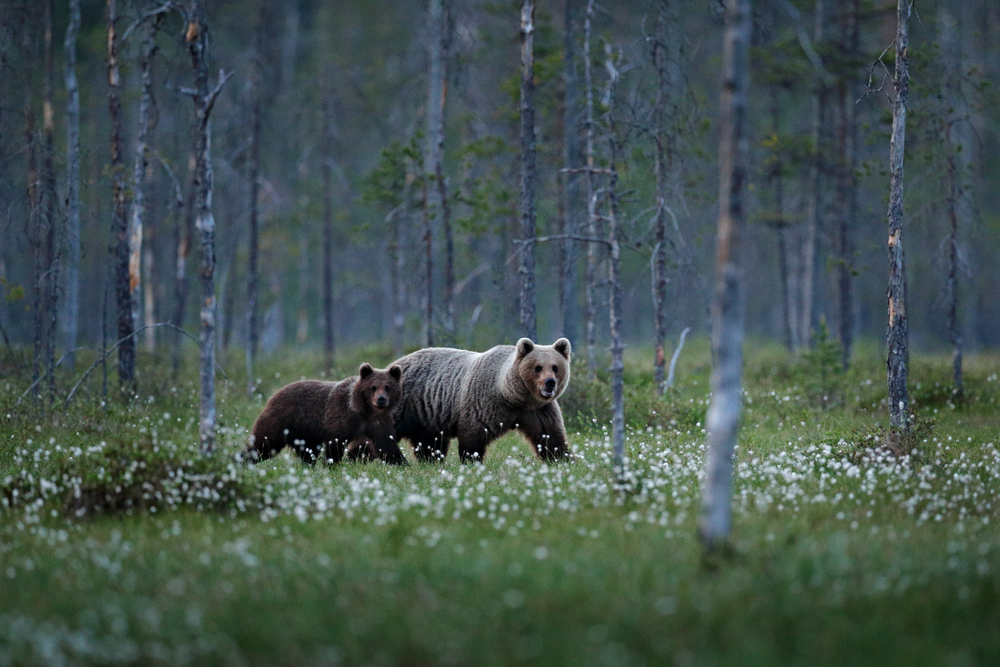The European Brown Bear, also known as the Russian Bear, is the national animal of Russia.
Russian bears are strong and brave animals. Like Russia, they can be fierce if prodded or cornered. Most of the time – just like other types of bears – Russian bears go about living their lives, trying to survive in a harsh, cold world.
During the 20th Century, the bear was taken up as a symbol by the Russian people. They introduced a bear cub as a mascot at the 1980 Moscow Olympics. The cub was cute and cuddly, not a bit fierce.
Table of Contents
Were Russian bears used in propaganda?

Yes, in years past, the United States and other countries used Russian Bear cartoons to make fun of the Russians. The Russians used eagle cartoons to make fun of us!
None of this was done in the name of flattery or friendship, that’s for sure. Hopefully, when the cold war ended, all of that became water under the bridge.
Since the 2000s, the bear has officially been the symbol of the United Russian Party. The real bears, of course, have no idea that they are a political symbol or a mascot for a country.
Do Russian bears have other names?
Yes, these big brown bears found in Europe and Russia go by many names. They are called European brown bears, Eurasian brown bears, common brown bears, and Russian bears.
Their scientific name is Ursus arctos arctos. Isn’t that a mouthful?
What do Russian bears look like?

On average, an adult Russian bear is five feet long and weighs around 500 pounds. Some have been known to get much larger, weighing over 800 pounds.
Like with most mammals, the males are much bigger than the females.
The Russian bear is not hindered by its size. These bears can run and climb trees and they are also good swimmers.
Russian bears have broad heads, small round ears, long snouts, and a stubby tail that is buried by thick fur. They have a very distinctive appearance – you will know a bear when you see one.
What do Russian bears eat?
Russian Bears are omnivores. Russian bears love meat and fish but will settle for plants and vegetables if necessary. They like fruits, nuts, acorns, roots, herbs, insects, grass, and green plants.
Russian bears will also eat carrion when they find it. They need 20,000 calories a day to put on enough fat to survive the winter months. That is a lot of food when you consider a working man needs only 3,500.
When do the bears mate?

The Russian bears’ breeding season is in May, June, and July. Bears mate several times a year with several different partners. After mating, the males and females don’t hang around together.
The female Russian Bear can carry a fertilized egg around for months before it becomes lodged in the uterus. This usually happens at the beginning of winter.
During hibernation, gestation begins.
How many cubs do Russian bears have?
Russian bear mothers usually have two or three cubs. Cubs are born inside the den during the middle of winter. The baby bears are blind and furless, but by spring they are ready to go outside with their mother.
Adult female bears are the most dangerous at this point. They will fight to the death for their young. Cubs stay with their mothers for two years.
Around that time, the female is ready to mate again and sends the young bears on their way to fend for themselves.
Do they have Bear Festivals in Russia?

Yes, but not exactly the type of festivals we have in the United States. They are not held to attract tourists.
The Nivkh people of Eastern Russia include Russian Bears in their religious ceremonies. They believe that the bear is a sacred manifestation of their ancestors in animal form.
Nivkh women have been known to capture cubs and raise them like children. The tame bears are dressed in ceremonial clothing and given all kinds of treats to eat.
During the Bear Festival, on the day of the main feast, the people perform sacrificial rituals. The tame bear is killed, eaten, and its spirit is sent to the gods of the mountains.
Poor bear! Thankfully, this practice is now highly discouraged.
How long do Russian bears live when in the wild?
Bears can live long lives if given the chance. Russian brown bears can live up to 30 years in the wild, but many only make it to five or six.
Malnutrition and diseases contribute to their low life expectancy, so do poachers, hunters, and traffic. Many bears are hit by cars and trucks – a big problem on Russian highways.
In many European countries, brown bears are protected by law. International agreements are in place around the globe to keep these bears safe.
Organizations like The Washington Convention on International Trade in Endangered Species of Wild Fauna and Flora do what they can to protect Russian bears and other wildlife.
Nowadays, the habitat is shrinking more than ever as trees are cut down in the name of progress. This is nothing new.
Since the Middle Ages, bear habitats have been shrinking, driving the animals into the mountains and other inaccessible areas.
Where do Russian bears live?

Their preferred home is deep in the forest, away from humans. Bears are shy by nature but can become a nuisance if fed or allowed access to garbage. Bears are solitary animals and do not like to share their territories.
There are more European brown bears in Russia than in any other country. The Russians chose well when they picked the bear as their national animal.
There are more of them living in Russia than anywhere else in the world. Besides Russia, there are still fairly large populations in the Carpathian Mountains, Scandinavian countries, and Balkan countries, especially Romania.
Aren’t some Russian and European brown bear populations considered endangered species?
Yes. Brown bear populations in Switzerland and the Alps are all highly endangered. There is hope that bears in some of these endangered areas will make a come-back.
Several environmental groups that study endangered species report rising numbers of European brown bears in Spain’s Cantabrian Mountains. They have been steadily increasing since the 1990s. That is good news!
Is the Russian bear respected as Russia’s national animal?

Yes, Russians love their bears. The bear is an honorable animal that deserves its recognition. Bears have been a part of Russian culture for centuries.
They are amazing creatures. Not only are they beautiful and smart, but they are also some of the most interesting animals on the planet.
Russian bears are a fine symbol for any people or country.

















